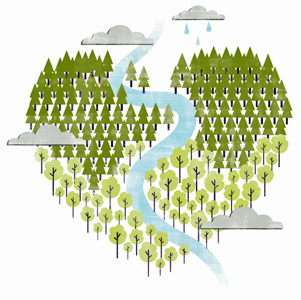Paper Grows Trees...Quite Fast!
![]() Print this Article | Send to Colleague
Print this Article | Send to Colleague
The following item is by Phil Riebel, president of Two Sides North America, Chicago, Ill., USA
 Forest products such as paper can support a vibrant and renewable forest cycle that can be sustainably managed for the long-term.[i]
Forest products such as paper can support a vibrant and renewable forest cycle that can be sustainably managed for the long-term.[i]For many years, International Paper's Go Paper. Grow Trees campaign and Print Grows Trees operated by the Printing & Graphics Association MidAtlantic have been promoting the vital link between paper/print and the long-term retention of privately-owned (including family-owned) forest lands. In short, a strong market for pulp, paper, lumber, and other forest products, does grow trees.
In North America we grow many more trees than we harvest. Forest area in the U.S. increased by 5,800 NFL football fields per day between 2007 and 2012, or a total of 14 million acres.[ii] In Canada, the forest cover has remained stable during the past two decades and, in recent years, Canada’s actual harvest has been 44% of annual growth.[iii]
To illustrate the powerful renewable features of well managed North American forests, we calculated how much time it takes to grow some well-known paper products: a standard #10 envelope and a ream of office copy paper (500 sheets). The results may surprise you!
Calculation methods
It is possible to estimate the time needed to grow wood fiber for certain paper products on a given forest area. The results depend on which tree species are used to make these paper products and the age and growing conditions of the trees. Soil fertility and moisture, drainage conditions, and the number of trees per acre all affect tree growth rate.Tree species also vary widely in their wood density: a higher density wood will produce more fiber for the same weight than a low density wood.
The necessary data and fiber growth rate calculations were obtained from the literature for nine tree species used in pulp and paper production and occurring under different growing conditions in the U.S. and Canada. The objective of this exercise was to develop estimates of the time it takes to grow the wood fiber necessary for the given paper products.
A detailed data table is available online.
Results
The time required to grow the fiber needed for a #10 envelope is 0.3 to 1.9 seconds per 100 acres of managed North American forest.
The time required to grow the fiber needed for a ream of 500-sheet office paper is 0.3 to 2.2 hours per 100 acres of managed North American forest.
The fastest growth rates were for loblolly pine and hybrid aspen, and the slowest for black spruce, with climate and temperature playing a large role in growth rates.
Given the above, a forest land owner or tree farmer who has 100 acres of commercial pulpwood could produce enough wood fiber for the following products, with just the new tree growth achieved in one year:
- 15.8 million #10 envelopes, or
- 4,000 reams of copy paper (500 sheets each).
A market for paper products also benefits local communities given that a portion of the income from wood sales is re-injected in local businesses and services.
Conclusion
Given the progress of sustainable forestry in North America, environmental claims related to forest products such as paper must consider the renewability and growth of well managed forests. In other words, claims such as "go paperless – go green" or "save trees" mislead consumers into believing that paper is a cause of deforestation (permanent forest loss) when it clearly is not. Well managed forests provide a multitude of environmental, social, and economic benefits to thousands of North American communities. They are also key to helping mitigate climate change due to carbon sequestration, and promoting biodiversity compared with other land uses.
For more on these features of paper, see the Two Sides Fact sheets or Myths and Facts series.
[i] UN Food and Agriculture Organization, 2015
[ii] USDA Forest Service, 2014
[iii] The Conference Board of Canada, 2014


